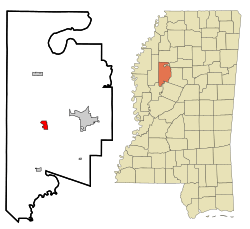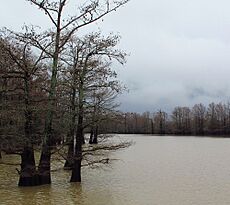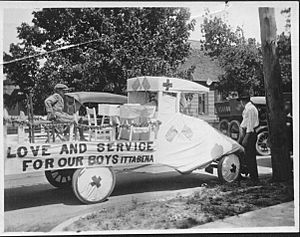Itta Bena, Mississippi facts for kids
Quick facts for kids
Itta Bena, Mississippi
|
|
|---|---|

Home in the Woods
|
|

Location of Itta Bena, Mississippi
|
|
| Country | |
| State | |
| County | Leflore |
| Area | |
| • Total | 1.46 sq mi (3.77 km2) |
| • Land | 1.41 sq mi (3.65 km2) |
| • Water | 0.04 sq mi (0.12 km2) |
| Elevation | 125 ft (38 m) |
| Population
(2020)
|
|
| • Total | 1,679 |
| • Density | 1,189.94/sq mi (459.48/km2) |
| Time zone | UTC−6 (Central (CST)) |
| • Summer (DST) | UTC−5 (CDT) |
| ZIP code |
38941
|
| Area code(s) | 662 |
| FIPS code | 28-35260 |
| GNIS feature ID | 2404772 |
Itta Bena is a small city located in Leflore County, Mississippi, in the United States. In 2020, about 1,679 people lived there. The city's name comes from the Choctaw language, and it means "forest camp." Itta Bena grew up as a place where cotton plantations traded their goods. It is also part of the larger Greenwood, Mississippi micropolitan area.
Contents
History of Itta Bena
Early Beginnings and Native Americans
For hundreds of years before European settlers arrived, the native Choctaw people lived in the Delta region. Their ancestors had lived there for thousands of years. In 1830, the Choctaw signed the Treaty of Dancing Rabbit Creek. This treaty was part of the Indian Removal Act. The Choctaw gave up about 11 million acres of their land in Mississippi to the United States. In return, they received land in what is now Oklahoma.
Founding of the City
Benjamin G. Humphreys is known for starting Itta Bena. In the 1850s, he had problems with his crops in another part of Mississippi. He decided to explore the Yazoo wilderness to find new land for farming.
He found a good spot near Roebuck Lake, which was an old river channel. In the winter, he brought a group of enslaved people from his plantations. They used boats to travel on the high water from the Yazoo River to Roebuck Lake. There, they worked to clear trees and bushes to create fields for growing cotton.
Humphreys built a home called "Lucknow" in Claiborne County. He did not bring his family to the Itta Bena plantation until 1857. That year, enslaved people finished building a large home for him. He named this home Itta Bena, which means "camp in the woods" in Choctaw. The house was made from wood from the plantation land. It was one of the first big homes in the Yazoo area. After the American Civil War, Humphreys became the governor of Mississippi.
As more people moved to the area, the village that grew around the plantation was also called Itta Bena. Farmers used the Yazoo River to send their cotton downriver. This cotton was then shipped to markets in the United States and Great Britain. Cotton farming continued to be very important after the Civil War.
Growth and Development
In 1888, the Columbus and Greenville Railway began to serve Itta Bena. This helped the town grow and trade more. Some of the first stores were built by J. B. Humphreys, P. Cohen, and Uriah Ray. The first store was run by H. M. Weber and a man named Long.
The town's first school was built in 1888. It was a one-room building only for white students. Emma Cross was the first teacher. In 1905, the first high school was built. The post office in Itta Bena opened in 1918.
Civil Rights Era and Recent Times
During the 20th century, many African Americans left the area. They moved to cities in the North and Midwest to find jobs. This movement is known as the Great Migration.
In 1966, a march for civil rights took place between Itta Bena and Greenwood. Martin Luther King Jr. led this march. During this event, Stokely Carmichael used the famous phrase "Black power!" to rally people.
Itta Bena's population was largest in 1980. Since then, the number of people living in the city has gone down. This is because there are fewer job opportunities in the area.
Geography of Itta Bena
Itta Bena covers about 1.5 square miles (3.77 square kilometers). Most of this area is land, about 1.4 square miles (3.65 square kilometers). A small part, about 0.04 square miles (0.12 square kilometers), is water.
Population and People
The city's population has changed over the years.
- In 1900, there were 416 people.
- By 1910, it grew to 1,427 people.
- The population reached its highest in 1980 with 2,904 people.
- In 2010, the population was 2,049.
- By 2020, it was 1,679 people.
Who Lives in Itta Bena?
Based on the 2020 census, there were 1,679 people living in Itta Bena.
- About 92.32% of the people were Black or African American (not Hispanic).
- About 4.76% were White (not Hispanic).
- About 1.43% were of other races or mixed races.
- About 1.49% were Hispanic or Latino.
Education in Itta Bena
Mississippi Valley State University is located about 1 mile (1.6 km) northwest of Itta Bena. This university was once a college for Black students in Mississippi before schools were integrated. The university's football team, the Delta Devils, plays at the 10,000-seat Rice–Totten Stadium in Itta Bena.
The public schools in Itta Bena are part of the Greenwood-Leflore Consolidated School District. These schools include Leflore County Elementary School and Leflore County High School.
Notable People from Itta Bena
Many interesting people have connections to Itta Bena:
- Andre Allen – a former football player in the Canadian Football League.
- Smoky Babe – a blues musician.
- Marion Barry – a civil rights activist and former mayor of Washington, D.C.
- James Bevel – a civil rights activist.
- Robert "Big Mojo" Elem – a Chicago blues bass guitarist and singer.
- Katie Hall – a U.S. Representative from Indiana who attended Mississippi Valley State University.
- Luther "Guitar Junior" Johnson – a blues musician.
- B.B. King – a famous blues musician, born near Itta Bena in 1925.
- Jimmy Lewis – a soul singer, producer, and songwriter.
- Lewis Nordan – an author who grew up in Itta Bena.
- Robert Petway – a delta blues musician, possibly born here in 1903.
- Euvester Simpson – a voting rights activist and member of the Student Nonviolent Coordinating Committee (SNCC).
- Pervis Spann – a broadcaster and music promoter.
See also
 In Spanish: Itta Bena para niños
In Spanish: Itta Bena para niños




